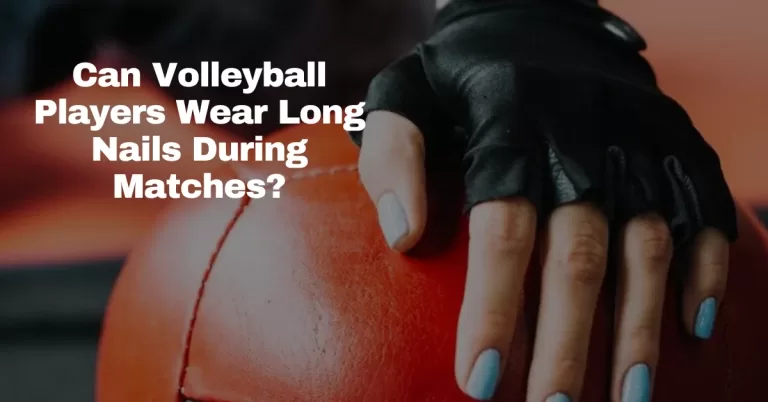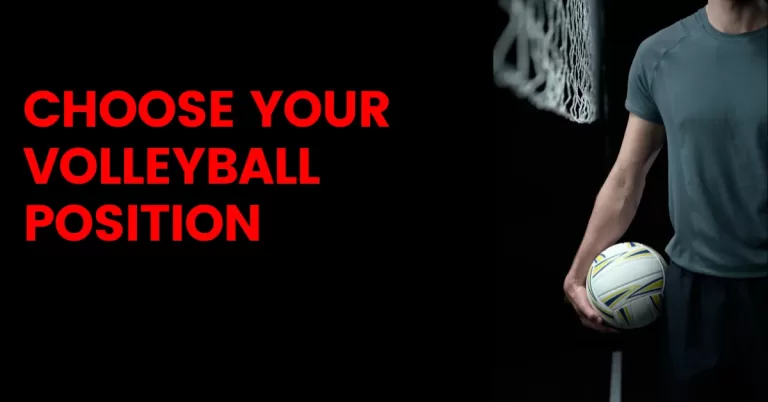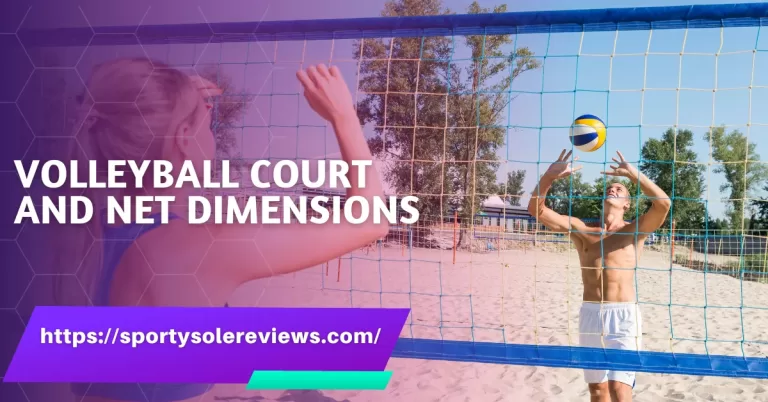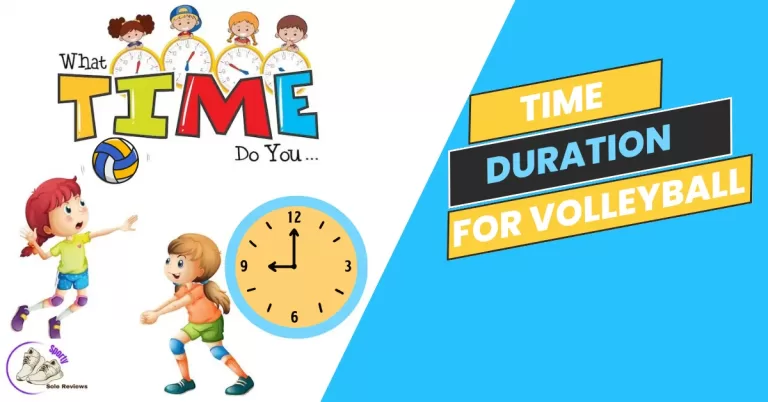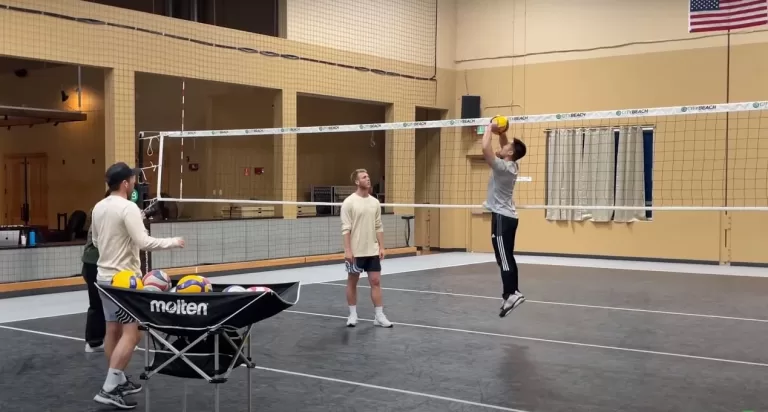Can You Kick the Ball in Volleyball? Unraveling the Rules
Volleyball has some rules that keep things fair and exciting. But you might be wondering, Can you actually kick the ball in volleyball? It’s a bit of a head-scratcher! As a player, I’ll tell you the game and find out if kicking is a thing or just a wild rumor!
| Section | Subsection | Description |
| Bumping (Forearm Pass) | Proper Technique | This fundamental technique involves striking the ball with the forearms. Maintain a firm, yet relaxed stance, with your knees bent, and interlock your fingers to create a stable platform. Timing is key; bump as the ball reaches your midsection. |
| When to Use Bumping | Bumping is your go-to when the ball comes at you fast and low. It’s also crucial in passing the opponent’s serve accurately to set up your team’s attack. | |
| Common Mistakes to Avoid | While bumping, watch out for improper posture, stiff arms, or swinging your elbows too much. These errors can lead to inaccurate passes. | |
| Setting (Overhead Pass) | Correct Form for Setting | Setting is an art in itself, demanding precise hand positioning and touch. When setting, your hands should form a diamond shape, with fingers spread wide. Use your legs to generate power, and contact the ball just above your forehead’s hairline. This technique is perfect for delivering accurate balls to your spikers. |
| When to Use Setting | Employ setting when you need to set up a teammate for an attack. It’s the playmaker’s move to orchestrate your team’s offensive strategies. | |
| Common Setting Errors | Common setting errors include lifting the ball (double contact) or setting too close to the net, making it difficult for the spiker to attack effectively. | |
| Spiking (Attacking) | How to Execute a Spike | Spiking is the offensive powerhouse of volleyball. When you decide to spike, focus on your approach; coordinate your steps, jump, and arm swing. Aim for the top of the ball, utilizing your wrist snap to add spin and control. Timing is paramount; strike the ball at its peak. |
| When to Spike | Choose to spike when the ball is set ideally for you, and there’s a chance to exploit the opponent’s defense. A well-timed spike can be a game-changer. | |
| Mistakes to Watch Out For | Avoid spiking errors like hitting the net, going out of bounds, or telegraphing your intentions to the opposing blockers. | |
| Serving | Types of Serves | Serving offers a chance to control the game’s tempo. There are various types of serves, such as the float serve and the topspin serve. Experiment with them to keep your opponents guessing. |
| Serving Techniques | Ensure your toss is consistent, and practice your serving technique regularly to minimize common errors like serving into the net or out of bounds. |
Understanding the Official Rules of Volleyball
In volleyball, the primary objective is to send the ball over the net and land it within the opponent’s court while preventing the opposing team from doing the same. Each team consists of six players in team, and they must adhere to specific rules governing various aspects of the game.
Rules on Ball Contact
The rules on ball contact are essential for proper gameplay. Players must use clean hits, such as open-handed volleys or closed-fist shots, to ensure the ball remains in play. Intentional contact with any part of the body other than the hands and arms is generally considered a violation.
Rules on Player Contact
Player contact is closely monitored to prevent interference and promote safety. Physical contact with opponents, such as hitting, blocking, or reaching over the net, is restricted to designated areas and must not disrupt the opposing team’s play.
Rules on Court Boundaries
The volleyball court has strict boundaries that players must respect. Stepping over the lines during gameplay results in penalties. Additionally, players must remain within their assigned positions during serves and rotations.
Rules on Scoring and Rotation
Volleyball uses a rally scoring system, meaning a point is awarded on every play, regardless of which team serves. Proper rotation is essential, ensuring players move in a clockwise manner to maintain their positions on the court.
The pros and cons of kicking in volleyball
Volleyball, a sport primarily centered around using hands and arms for ball contact, rarely involves kicking. However, exploring the potential advantages and disadvantages of kicking in volleyball can shed light on the complexities of this unconventional technique.
Advantages of Kick the ball in volleyball
- Surprise Element and Unpredictability: Incorporating kick the ball in volleyball during gameplay can catch opponents off guard, adding an element of surprise and unpredictability to the match.
- Extended Reach and Quick Reactions: Kicking allows players to extend their reach, making saves and returns possible even in challenging positions. Quick reactions from the feet can be advantageous in sudden, unexpected situations.
- Overcoming Obstacles and Inaccessibility: When the ball is out of reach of a player’s hands, a well-timed kick of the ball in volleyball can provide a means to keep the ball in play, overcoming obstacles or inaccessibility.
Disadvantages of kicking the ball
- Lack of Control and Accuracy: Kicking inherently lacks the precision and control that hand contact offers, making it challenging to direct the ball accurately.
- Potential for Injury and Safety Concerns: Kicking introduces the risk of injury to both the kicker and other players on the court, especially when attempted without proper technique or in crowded spaces. As a player, I know about volleyball injuries. You can protect yourself from injury.
- Violation of Traditional Volleyball Techniques: Volleyball’s established techniques prioritize hand and arm contact, and relying on a kick the ball in volleyball may lead to violations of the sport’s traditional principles.
What is considered legal contact in volleyball?
In volleyball, legal contact is limited to using hands and arms to handle the ball. These regulations ensure fair play and uniformity in the game. Players are trained to employ specific techniques, such as setting, bumping, and spiking, to maintain control over the ball during rallies.
Is kick the ball in volleyball allowed?
Traditionally, kicking the ball is not permitted in volleyball. The sport’s rules prioritize the use of hands and arms for ball handling, emphasizing skill and technique over other forms of contact.
Exploring the Official Rules
The official volleyball rules, established by organizations such as the Fédération Internationale de Volleyball (FIVB) and USA Volleyball, explicitly state that intentional contact with the ball using any part of the body other than hands and arms is not allowed.
Instances Where Kicking is Permitted
Despite the general prohibition, there are rare instances where incidental or unintentional contact with a player’s foot or leg may occur during a rally. In such cases, the referee must make a judgment call based on the context of the play.
Instances Where Kicking is Prohibited
Intentionally kicking the ball to gain an advantage or disrupt the game is strictly prohibited. Players attempting to kick the ball in volleyball deliberately may be penalized, resulting in a loss of point or possession for their team.
The Role of Referees in Deciding Legal Kicks
Referees play a crucial role in determining whether a kick in ball in volleyball was accidental or intentional. Their expertise ensures fair and consistent decisions, maintaining the integrity of the game.
Famous Moments of Kick the ball in Volleyball
Throughout the rich history of volleyball, there have been rare and iconic instances of players using their feet to interact with the ball, defying the traditional norms of the sport. These moments have left a lasting impact on both players and fans, showcasing the versatility and creativity within the game.
Highlighting Iconic Instances of Kicking
- Remarkable Saves and Score-winning Kicks: In high-pressure situations, some players have resorted to kicking the ball to keep it in play, resulting in spectacular saves that turned the tide of the match.
- Memorable Trick Plays and Exhibition Matches: Volleyball exhibitions often bring forth entertaining trick plays, where players showcase their athleticism and flair, occasionally incorporating skillful kicks to dazzle spectators.
- Instances of Controversy and Rule Interpretation: Certain competitive matches have witnessed controversial moments where players attempted kick the ball in volleyball, leading to debates about whether these actions violated the rules or not.
Conclusion
Understanding the established rules and regulations surrounding ball contact is essential for fair play and maintaining the integrity of the sport. By weighing the pros and cons, we recognize the potential for creativity and surprise that Kicks bring to the game. Embracing innovation while preserving the fundamental techniques will be key to shaping the future of kicking in volleyball and captivating players and fans alike. Is kicking the ball allowed in volleyball? As the sport evolves, only time will tell how this unconventional technique finds its place in the exciting world of volleyball.
Is kick the ball allowed in volleyball?
No, kicking the ball is generally not allowed in volleyball. The sport’s rules prioritize the use of hands and arms for ball handling, and intentional contact with any other body part is considered a violation. However, there have been rare instances of incidental or unintentional kicks during gameplay.
Can players use their feet for saves in volleyball?
While players are not allowed to intentionally kick the ball in volleyball, there have been remarkable instances of players using their feet for saves during intense rallies. These moments often demonstrate the players’ quick reactions and athleticism.
Are there any benefits to kicking in volleyball?
Some argue that kicking could introduce an element of surprise and unpredictability to the game. It may also offer extended reach in certain situations and help overcome obstacles. However, the lack of control and accuracy when compared to hand contact remains a significant drawback.
Could the rules on kicking in volleyball change in the future?
The future of kicking in volleyball remains uncertain. Rule changes and innovations in the sport may open the door to new possibilities, but maintaining a balance between tradition and innovation will be crucial to preserving the essence of volleyball.



